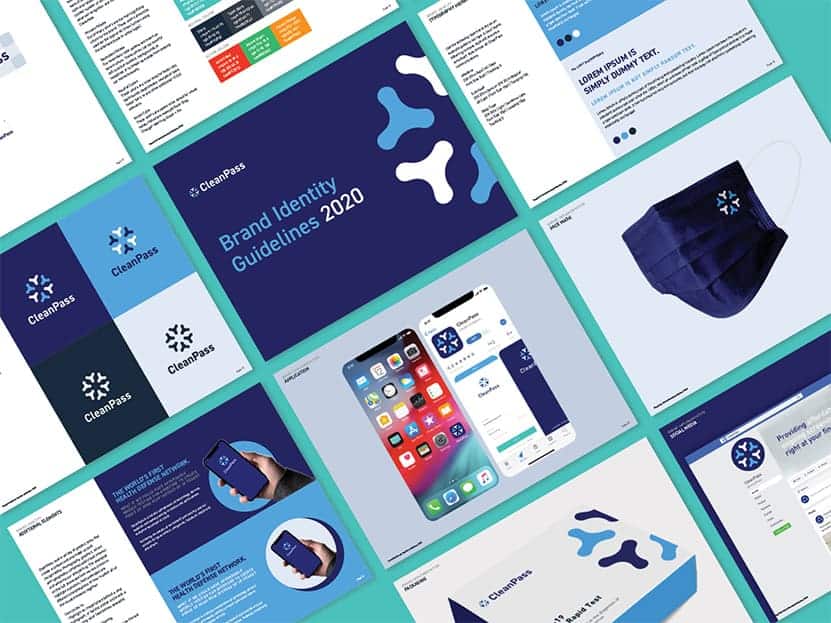The branding industry is all over the place when it comes to defining Brand Identity Guidelines. Ask ten branding experts, and you’ll get ten different answers. But drill down, and you’ll find similar basics.
At Branding For The People, we describe them as a set of principles that govern how the brand looks, speaks, and behaves. Its purpose is to keep everyone who touches your brand working synergistically. It provides a set of parameters that keeps every brand touchpoint consistent with the Brand Strategy, i.e. “on-brand.”
Brand Identity Guidelines start with your Brand Platform. Once your Brand Platform is defined, then you outline your Brand Experience.
From there, you build the guidelines that every user will follow. This makes the Brand Experience happen in a friendly, orderly way.
Columbia U. published research to define the brand experience:“Brand experience is conceived as sensations, feelings, cognition, and behavioral responses evoked by brand-related stimuli. This includes every part of a brand’s design: identity, packaging, messages, and environment.”
We experience brands through a variety of senses. We understand the brand through our feelings and thoughts. That’s because branding happens in the subconscious part of the brain. We never ‘think’ about it.
Start by focusing on being clear in your Brand Experience. Clear words simplify the team taking it on and supporting it. Within your Brand Experience, you need to cover each of these aspects:
- Your ideal client
- Who you are
- Your purpose (why you exist)
- What makes your brand unique
- Your brand personality
- Your voice
- Your unique brand positioning
- Message matrix
- Visual elements like your logo and colors
- Fonts and typography to be used
As you create these, focus on the triggered emotional experiences. That means responses to color, shape, style, and brand persona.
Are you just starting to develop your brand? First, consider our How to Create a Brand Strategy. This guide walks you through each element of your brand. Once you have that, check out our Brand Development 101: A Complete Guide. These can help you develop your Brand Experience. Once detailed, you can encompass it in your Brand Identity Guidelines.
Build Brand Identity Guidelines from the Brand Experience
The purpose of the guidelines is to make things more consistent. You’ll have more uniform messages, logos, colors, fonts, and even comma use. Without guides, messages tend to get off-brand quickly.
From our client work, we know what happens without Brand Identity Guidelines. Our clients tell us they wasted time, money, and resources.
When deciding what is on-brand, everything goes up for debate. Messages can get confused. The problems extend from landing pages to web content. And then there is the marketing material. And it’s across both verbal and text.
Guidelines involve all users— team members, partners, and agencies. With the Brand Identity Guidelines in place, they have set standards for use. Those standards also encourage users to follow the guides.
The result is on-target messages. Ones that are uniform across your Brand Experience. All messages are clear, drive action, and are unique. They also work together, are unified, and are growth focused.
You Need to Steer Expectations
The guidelines steer expectancy in and outside the company. They must address the needs of different users. And each unique user must find guidance. So the Guidelines need to cover all possibilities in one document.
In the guides, we describe each element of the brand. Then cover how users put them to work. Everyone has access to the information. This allows them to create consistent messages.
We define and describe each brand element.
- Logo
- Color
- Fonts and typography
- Imagery
- Voice
- Design
- Positioning
We Convert the Brand Experience Into Usable Steps
The Brand Experience focuses on emotions. The BIG focus is on how to use the elements creating those emotions. The guide covers use in both marketing and customer care.
Keep in mind the guidelines need to be specific. This means even a new user will have no issues following them. Sticking to them creates clear, driving, unique messages. It focuses on your brand value and story. It keeps every message united with the Brand Experience.
Guide Visitors Through the Buying Process
The message and the UX need to stay on-brand throughout the buyers’ journey. That means addressing each stage of that journey one by one. You must guide them from the moment they start to become aware. Then coach them through considering, purchasing, and becoming a brand advocate.
The guides also support lead generation. They help ensure you attract the right target audience. You want those that will understand and embrace your purpose. And you want to screen out those who aren’t a good fit.
Peloton does a great job of this. Peloton “sells happiness” to committed fitness buffs. By super targeting, their subscription retention rate is a skillful 95%. And their monthly churn rate is a tiny 0.65%. Their fervent fans are telling all their friends and driving brand growth.
Guidelines Keep Evolving
The Brand Identity Guidelines are a process that keeps evolving. Through ongoing use, you’ll discover missing components and tweak them. The results are a detailed set of helpful instructions for all users. Uniform messages assure building stronger customer ties. Better fusion into the plan makes them more powerful. And an even tenor ramps up your brand exposure. Following the guidelines is how it’s achieved.
We’ve seen sticking to Brand Identity Guidelines helps grow internal brand pride. That helps excite both your team and your customers. This leads to growth, sales, and happy fans.
But it starts with creating all the components first. Once they are in place, then you can create your Brand Identity Guidelines.







